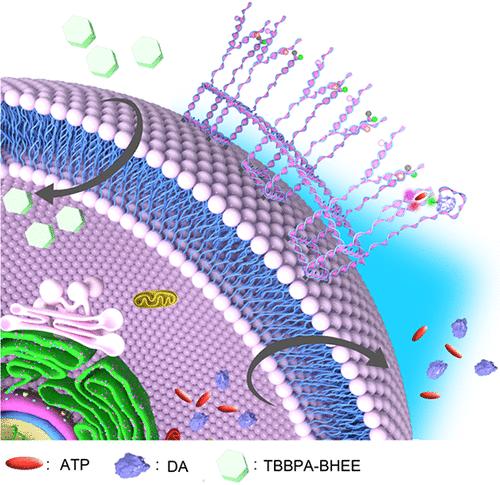用于多种细胞毒性相关生物标志物原位监测的串联立方DNA纳米结构细胞膜表面传感平台
IF 6.7
1区 化学
Q1 CHEMISTRY, ANALYTICAL
引用次数: 0
摘要
新兴有机污染物被认为对人体具有广泛的毒性。然而,由于缺乏在活细胞水平上跟踪内源性生化因子的合适方法,对这一毒理学过程的监测受到阻碍。为了解决这一技术挑战,本研究开发了一种以串联立方DNA纳米结构(tcdn)为主要结构的细胞表面荧光传感平台。通过几个预制DNA线框模块的精确组装,一组线性纳米超结构可以有效地锚定在细胞膜表面。此外,两种不同的靶向三磷酸腺苷(ATP)和多巴胺(DA)的适配体荧光识别元件可以在tcdn上以等距排列修饰,作为监测内源性细胞生化因子的核心组件。我们以四溴双酚a双(2-羟乙基醚)(TBBPA-BHEE)诱导的活细胞作为毒性效应系统,以直接可视化的方式监测内源性ATP和DA的释放。在此基础上,探讨了两种内源性生化因子(ATP和DA)浓度与不同TBBPA-BHEE暴露条件的相关性。我们相信这项工作可以为研究污染物引起的细胞毒理学机制提供一个强大的和有前途的工具。本文章由计算机程序翻译,如有差异,请以英文原文为准。

A Tandem Cubic DNA Nanostructures Cell Membrane Surface Sensing Platform for In Situ Monitoring of Multiple Cytotoxicity-Related Biomarkers
Emerging organic pollutants (EOPs) are considered to exhibit extensive toxicity to the human body. However, monitoring of this toxicological process is hampered by the shortage of suitable methods to track endogenous biochemical factors at the living cell level. To solve this technical challenge, a cell surface fluorescent sensing platform using tandem cubic DNA nanostructures (tCDNs) as the main architecture is developed in this work. With the precise assembly of several prefabricated DNA wireframe modules, a set of linear nanosuperstructures can be efficiently hydrophobic anchored to the cell membrane surface. Furthermore, two different aptamer-based fluorescence recognition elements targeting adenosine triphosphate (ATP) and dopamine (DA) can be modified on top of tCDNs in an equidistant arrangement, serving as a core component for monitoring endogenous cellular biochemical factors. As a typical example, we used tetrabromobisphenol A bis(2-hydroxyethyl ether) (TBBPA-BHEE)-induced living cells as a toxic effect system to monitor the release of endogenous ATP and DA in a direct visualization manner. On this basis, the correlation between the concentrations of these two endogenous biochemical factors (ATP and DA) and different TBBPA-BHEE exposure conditions was explored. We believe that this work can provide a robust and promising tool for studying the cellular toxicological mechanisms caused by pollutants.
求助全文
通过发布文献求助,成功后即可免费获取论文全文。
去求助
来源期刊

Analytical Chemistry
化学-分析化学
CiteScore
12.10
自引率
12.20%
发文量
1949
审稿时长
1.4 months
期刊介绍:
Analytical Chemistry, a peer-reviewed research journal, focuses on disseminating new and original knowledge across all branches of analytical chemistry. Fundamental articles may explore general principles of chemical measurement science and need not directly address existing or potential analytical methodology. They can be entirely theoretical or report experimental results. Contributions may cover various phases of analytical operations, including sampling, bioanalysis, electrochemistry, mass spectrometry, microscale and nanoscale systems, environmental analysis, separations, spectroscopy, chemical reactions and selectivity, instrumentation, imaging, surface analysis, and data processing. Papers discussing known analytical methods should present a significant, original application of the method, a notable improvement, or results on an important analyte.
 求助内容:
求助内容: 应助结果提醒方式:
应助结果提醒方式:


